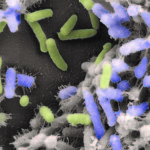Link to Pubmed [PMID] – 15165237
Mol. Microbiol. 2004 Jun;52(5):1337-48
The Yersinia high-pathogenicity island (HPI) encodes the siderophore yersiniabactin-mediated iron uptake system. The HPI of Yersinia pseudotuberculosis I has previously been shown to be able to excise precisely from the bacterial chromosome by recombination between the attB-R and attB-L sites flanking the island. However, the nature of the Y. pseudotuberculosis HPI excision machinery remained unknown. We show here that, upon excision, the HPI forms an episomal circular molecule. The island thus has the ability to excise from the chromosome, circularize and reintegrate itself, either in the same location or in another asn tRNA copy. We also demonstrate that the HPI-encoded bacteriophage P4-like integrase (Int) plays a critical role in HPI excision and that, like phage integrases, it acts as a site-specific recombinase that catalyses both excision and integration reactions. However, Int alone cannot efficiently promote recombination between the attB-R and attB-L sites, and we demonstrate that a newly identified HPI-borne factor, designated Hef (for HPI excision factor) is also required for this activity. Hef belongs to a family of recombination directionality factors. Like the other members of this family, Hef probably plays an architectural rather than a catalytic role and promotes HPI excision from the chromosome by driving the function of Int towards an excisionase activity. The fact that the HPI, and probably several other pathogenicity islands, carry a machinery of integration/excision highly similar to those of bacteriophages argues for a phage-mediated acquisition and transfer of these elements.

